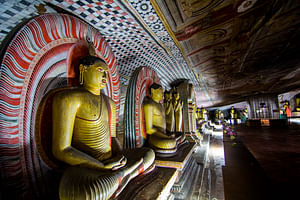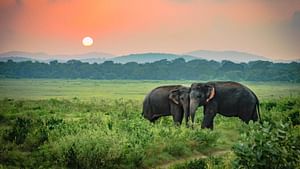Day 01 - Kandy
- We pick you up at the Airport or your hotel in kandy
- Surrounded by mountains, which are home to tea plantations and biodiverse rainforest. The city's heart is scenic Kandy Lake which is popular for strolling. Kandy is famous for sacred Buddhist sites, including the Temple of the Tooth (Sri Dalada Maligawa) shrine, celebrated with the grand Esala Perahera annual procession. This was the last capital of the Sinhala kings whose patronage enabled the Dinahala culture to flourish for more than 2,500 years until the occupation of Sri Lanka by the British in 1815. It is
- Visit Peradeniya Botanical Garden
- Have lunch
- The garden is famous for its countless (4000+) species of plants and trees. It is situated a 15-minute drive west of Kandy, and is a great escape from the city.
- Climbing the numerous steps to the top seeing the white colossal statue of Buddha named as Bahirawakanda Vihara gives one a sense of peace, serenity and harmony; and a stunning and gorgeous panoramic view of charming Kandy.
- Visit the Temple of the Tooth Relic
- The Temple of the Tooth Relic (the sacred tooth of the Buddha), which is a famous pilgrimage site, one of the most famous Buddhist temples in the world, which was built to protect the sacred tooth relic thought to belong to Lord Buddha, which has been enshrined in Sri Lanka for hundreds of years As well as a host of other temples, visitors to the city can wander along Kandy Lake, stroll through the stunning Botanical Gardens created by the British in the 19th century and still one of the most beautiful gardens in Asia.
- In the evening see the cultural show
- Kandyan dancing which was once native to the area but has now spread to different regions of the island and the show include of Magul Bera/Puja Netuma/Raban/Mayura Netuma/Pantheru Natuma/Gini Sisila/Ves Natuma(Fire walk). Climb the hill by Kandy Lake to reach Kandy view point and receive a view of the city that cannot be beaten.
- Check into the hotel
- Back to the hotel have dinner and stay overnight at the hotel.
Day 02 - Anuradhapura to Polonnaruwa
- Pick You up in the hotel in the morning after breakfast,
- leave Kandy to Anuradhapura.
- Anuradhapura is one of the ancient capitals of Sri Lanka, famous for its well-preserved ruins of ancient Lankan civilization. From the 4th century BC, it was the capital of Sri Lanka until the beginning of the 11th century AD. During this period it remained one of the most stable and durable centers of political power and urban life in South Asia. The ancient city, considered sacred to the Buddhist world, is today surrounded by monasteries covering an area of over sixteen square miles. Anuradhapura is also significant in Hindu legend as the fabled capital of the Asura King Ravana in the Ramayana.
- After having lunch we leave anuradhapura and take you to polonnaruwa
- Take sightseeing tour in ancient Polonnaruwa city.
- Another UNESCO world heritage site, according to the chronicles, during the 12th century a prince of great metal and physical vigour hailing from the Rohana (Southern part of Sri Lanka) forced his way to the throne of Sri Lanka as King Prakrama Bahu the great. Establishing himself in Polonnaruwa, a capital worthy of authority and ambition of the ruler, he proceeded to show himself as a successful warrior and a great administrator, during which time he, through a medium of a dam nine miles long created the Sea of Parakrama” harvesting rain water to be used in the dry period of the year for cultivation purposes, carving the irrigation brilliance of Sri Lankan’s in stone, when most of Europe where still in darkness. In a period of prosperity with the objective of storing food many such projects were undertaken some of which function even today. Today vast ruins stand sentinel bearing witness in Polonnaruwa to his power and glory.
- So after sightseeing in Polonnaruwa, drive you to the hotel in polonnaruwa
- checking into the hotel.
- Have dinner and stay overnight at the hotel in Polonnaruwa,
Day 03 - Sigiriya to Kandy
- Leaving the hotel in Polonnaruwa at 6:00 am in the morning to avoid the heat and the crowd who come to Sigiriya from the closest areas.
- Takeaway breakfast
- arrive at sigiriya
- Start the trekking
- Sigiriya, also called Lion Rock Situated in central Sri Lanka consisting of the ruins of an ancient stronghold that was built in the late 5th century on a remarkable monolithic rock pillar. Sigiriya was designated a UNESCO World Heritage site in 1982. The rock, which is so steep that its top overhangs the sides, rises to an elevation of 1,144 feet above sea level and is some 600 feet above the surrounding plain. The Sinhalese king Kashyapa built a palace in the shape of a monumental lion on the several acres of ground at the summit, intending it to be a safeguard against his enemies. However, the king was defeated in 495, and the palace fell into ruin. The site soon became a pilgrimage destination, however, and it is now a popular tourist spot. Visitors begin the final ascent to the top through the open paws of the lion, one of the few remaining portions of the palace that are still intact.
- And then after the excursion to Sigiriya, on the way back to Kandy
- see Dambulla Cave Temple,
- Dambulla cave temple also known as the Golden Temple of Dambulla is a World Heritage Site(1991) in Sri Lanka, situated in the central part of the country. It is the largest and best-preserved cave temple complex in Sri Lanka. The rock towers 160 m over the surrounding plains.There are more than 80 documented caves in the surrounding area. Major attractions are spread over 5 caves, which contain statues and paintings.
- we can stop and come to Kandy via Matale, stopping in the tourist attractions in Matale. (Hindu Kovil, Spice Growths, Noritake Porcelain Factory)
- Come back to Kandy and stay overnight at the hotel
.
Day 04 - Kandy (Three Temple Tour)
- Pick you up in the morning from your hotel in Kandy around 7 : 00 AM
- Proceed via gampola to explore the three lesser known temples in the area with a knowledgeable host.
- One of the most legendary attractions in gampola , the Embekke, Lankatilaka and Galadeniya are a short distance from each other and sometimes referred to as the three-temple loop. The temples serve as a living testimony to Sri Lanka’s Buddhist heritage, history and exceptional craftsmanship. Each temple holds a considerable amount of historical information of the ancient kingdom’s era, carved mostly in stone. Even if the temples themselves weren’t fascinating, and they are, the seven-kilometer path which connects Embekke, Lankathilaka and Gadaladeniya leads past rice fields and through small towns, and would be worth walking in its own right.
- Start off with Gadaladeniya Viharaya, a temple built exclusively by stone by Gampola’s King Bhuvanekabahu IV. Settled on a rock cliff, the temple exhibits a combination of Dravidian and Sinhalese architecture styles and offers its visitors a panoramic view of the countryside.
- Gadaladeniya temple which is made almost exclusively from stone and is considered one of the largest stone temples on the island. It is another example of an imposing temple built during the reign of King Buwanekabahu IV during the mid- fourteenth century and following the Sinhalese architecture style from the Polonnaruwa era. The main shrine in the temple has a seated Buddha statue underneath a dragon's arch (‘Makara Thorana’) which is richly decorated.
- Then enjoy a ride through paddy fields
- Reach the second temple, Lankathilaka, considered as the most magnificent architectural monument to be built during the Gampola era. During the experience, your host will talk you through the foundations of Buddhism and its significance in Sri Lanka. Before making your way to Embekka, a Hindu shrine, stopover at a plantation that grows tea, coffee and pepper to get a glimpse of the island’s numerous cultivations.
- Lankatilaka Vihara (monastery), the best example of architecture during the reign of King Buwanekabahu IV who made Gampola the capital of Sri Lanka during the mid-fourteenth century. Built on natural rock, the temple mixes stone, plaster and wood within its uniquely Sinhalese architectural style and is home to many ancient paintings which draw people from afar.
- Visit 3rd temple Embekke,
- Embekke temple was built by King Vikramabahu III to honour King Mahasena who ruled Sri Lanka from 277 to 304 AD. The Devalaya (temple) has three main areas; the Sanctum of Garagha, Dancing Hall and the Drummers Hall which is beautifully decorated with splendid wood sculptures and carvings of dragons and fierce battles between lions and elephants.
- By the end of the day we take you back to the hotel in kandy
















